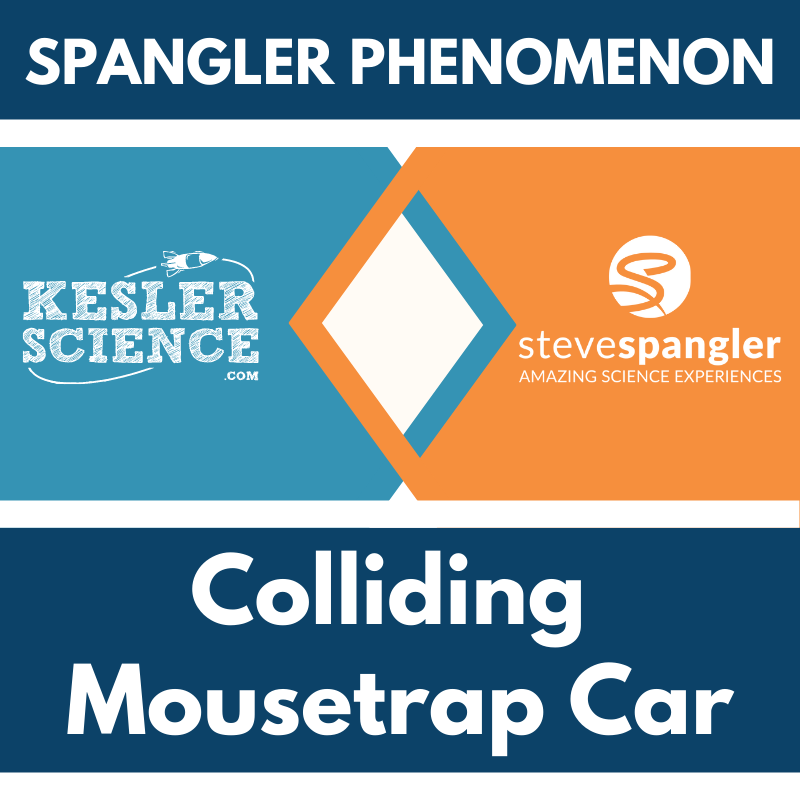Newton's Third Law & Collisions Activities for Middle School Science
Explore Newton’s laws with this engaging, student-led 5E lesson designed for middle school learners. With minimal prep, students investigate real-world applications in sports, amusement parks, tectonic forces, and rocket launches. The resources below will give students a comprehensive understanding of Newton's third law and collisions. All of the following materials are also included in the Kesler Science Membership.
The Kesler Science Newton’s Laws 5E Lesson is a comprehensive, student-led unit designed for middle school learners. It includes editable presentations, worksheets, choice projects, and assessments, requiring minimal prep while supporting differentiated instruction. The lesson engages students with essential questions about Newton’s laws and their real-world applications in sports, amusement parks, tectonic forces, and rocket launches.
Following the 5E Model, the lesson features engagement activities, a hands-on, differentiated exploration station lab with nine stations, and editable PowerPoints in both standard and interactive formats. Students can explore concepts through reading passages, experiments, videos, and research tasks, while output stations reinforce learning through writing, drawing, categorization, and assessment. Spanish translations are available for vocabulary, reading passages, and interactive notebooks.
Students extend their learning through choice projects and are assessed with STAAR 2.0-aligned questions, review worksheets, and modified evaluation options. The materials are adaptable for both in-class and virtual learning environments, ensuring flexibility and accessibility.
The Kesler Science Newton’s Laws 5E Lesson is a comprehensive, student-led unit designed for middle school learners. It includes editable presentations, worksheets, choice projects, and assessments, requiring minimal prep while supporting differentiated instruction. The lesson engages students with essential questions about Newton’s laws and their real-world applications in sports, amusement parks, tectonic forces, and rocket launches.
Following the 5E Model, the lesson features engagement activities, a hands-on, differentiated exploration station lab with nine stations, and editable PowerPoints in both standard and interactive formats. Students can explore concepts through reading passages, experiments, videos, and research tasks, while output stations reinforce learning through writing, drawing, categorization, and assessment. Spanish translations are available for vocabulary, reading passages, and interactive notebooks.
Students extend their learning through choice projects and are assessed with STAAR 2.0-aligned questions, review worksheets, and modified evaluation options. The materials are adaptable for both in-class and virtual learning environments, ensuring flexibility and accessibility.
Engage your students in an interactive, student-led exploration of Newton’s laws with this hands-on station lab. Designed to encourage independent learning, students investigate how an object's motion changes based on the sum of forces acting on it and its mass. Through structured, yet flexible activities, they deepen their understanding of force and motion while developing critical thinking skills.
This station lab includes nine differentiated activities that allow students to encounter and demonstrate their understanding of Newton’s laws in multiple ways. Input stations provide opportunities to explore concepts through hands-on demonstrations, research, reading, and videos. Output stations engage students in organizing information, illustrating models, writing responses, and completing assessments. A bonus challenge station extends learning with crosswords, games, and mini-projects for early finishers.
Designed for both in-class and virtual learning, this resource includes all necessary task cards, signage, and materials to minimize prep time while maximizing student engagement. Whether working individually or in small groups, students take ownership of their learning, making this an effective and adaptable addition to any middle school science curriculum.
Engage your students in an interactive, student-led exploration of Newton’s laws with this hands-on station lab. Designed to encourage independent learning, students investigate how an object's motion changes based on the sum of forces acting on it and its mass. Through structured, yet flexible activities, they deepen their understanding of force and motion while developing critical thinking skills.
This station lab includes nine differentiated activities that allow students to encounter and demonstrate their understanding of Newton’s laws in multiple ways. Input stations provide opportunities to explore concepts through hands-on demonstrations, research, reading, and videos. Output stations engage students in organizing information, illustrating models, writing responses, and completing assessments. A bonus challenge station extends learning with crosswords, games, and mini-projects for early finishers.
Designed for both in-class and virtual learning, this resource includes all necessary task cards, signage, and materials to minimize prep time while maximizing student engagement. Whether working individually or in small groups, students take ownership of their learning, making this an effective and adaptable addition to any middle school science curriculum.
The Newton’s Laws Student Choice Projects align with NGSS science standards, allowing middle school students to select a project that suits their preferred output style. A project page outlines six structured student-led options and a “design your own” project, with an editable rubric for teacher, peer, or self-assessment.
These projects are flexible and adaptable, offering multimodal choices for students to demonstrate their understanding creatively. Teachers can modify the rubric to fit grading needs. Two versions of the project page support differentiation, with targeted options for students needing remediation and opportunities for advanced learners to take on more challenging tasks.
The projects require standard classroom supplies such as paper, markers, and scissors, with many options available for digital completion. Some crafting materials may be useful for building models.
The Newton’s Laws Student Choice Projects align with NGSS science standards, allowing middle school students to select a project that suits their preferred output style. A project page outlines six structured student-led options and a “design your own” project, with an editable rubric for teacher, peer, or self-assessment.
These projects are flexible and adaptable, offering multimodal choices for students to demonstrate their understanding creatively. Teachers can modify the rubric to fit grading needs. Two versions of the project page support differentiation, with targeted options for students needing remediation and opportunities for advanced learners to take on more challenging tasks.
The projects require standard classroom supplies such as paper, markers, and scissors, with many options available for digital completion. Some crafting materials may be useful for building models.
The Newton’s Third Law Inquiry Lab aligns with NGSS MS-PS2-1, engaging students in hands-on or virtual investigations of Newton’s third law using balloon rockets. Students explore how increasing the inflation of a balloon affects the distance it travels along a string.
This lab includes both a digital and print format. The print version provides a structured, hands-on experiment where students work in groups using simple materials like balloons, string, and straws. Each student completes their own lab sheet, reinforcing individual accountability. The digital version is an interactive PowerPoint compatible with Google Slides, MS Teams, Schoology, and Canvas. It includes a recorded lab demonstration, allowing students to follow along as they conduct virtual experiments, making it ideal for absent students or classrooms without materials.
To support diverse learners, the lab offers three differentiated levels. The dependent version includes guided inquiry questions for on-level learners, the modified version provides structured instructions with simplified questions, and the independent version encourages advanced students to take full control of their investigation.
Editable PowerPoints allow customization, and all materials include teacher resource pages, answer keys, and Claim-Evidence-Reasoning (C.E.R.) prompts. The flexibility of print and digital formats ensures an engaging and adaptable experience for middle school science students.
The Newton’s Third Law Inquiry Lab aligns with NGSS MS-PS2-1, engaging students in hands-on or virtual investigations of Newton’s third law using balloon rockets. Students explore how increasing the inflation of a balloon affects the distance it travels along a string.
This lab includes both a digital and print format. The print version provides a structured, hands-on experiment where students work in groups using simple materials like balloons, string, and straws. Each student completes their own lab sheet, reinforcing individual accountability. The digital version is an interactive PowerPoint compatible with Google Slides, MS Teams, Schoology, and Canvas. It includes a recorded lab demonstration, allowing students to follow along as they conduct virtual experiments, making it ideal for absent students or classrooms without materials.
To support diverse learners, the lab offers three differentiated levels. The dependent version includes guided inquiry questions for on-level learners, the modified version provides structured instructions with simplified questions, and the independent version encourages advanced students to take full control of their investigation.
Editable PowerPoints allow customization, and all materials include teacher resource pages, answer keys, and Claim-Evidence-Reasoning (C.E.R.) prompts. The flexibility of print and digital formats ensures an engaging and adaptable experience for middle school science students.
The Newton’s Laws Escape Room is an interactive experience that engages students in demonstrating their understanding of Newton’s three laws through real-world applications. Before participating, students should be familiar with key vocabulary, including inertia, force, mass, acceleration, and friction. This activity aligns with NGSS MS-PS2-1 and MS-PS2-2.
Unlike traditional escape rooms, teachers can customize the experience by selecting from eight independent puzzles, making it adaptable to various class periods. The activity can be conducted using simple materials like manila envelopes or a more immersive setup with locks, hasps, and storage boxes. Printable materials and supply links are provided for flexibility.
For digital learning, a Single Student Digital Version is available as a PowerPoint file, which can be assigned via email or a learning management system. This version can also be uploaded to Google Drive and used with Google Slides. A printable version is offered as a PPT or PDF for at-home use, with copyright restrictions limiting sharing to individual classrooms.
Included in this resource are teacher directions, a detailed answer key, digital answer sheets for Google Classroom, a video challenge, eight unique puzzles with printable props, and over 50 prize ideas. Additional resources include reward templates and editable signs for post-game photos. This engaging escape room will leave students excited and eager to apply their knowledge.
The Newton’s Laws Escape Room is an interactive experience that engages students in demonstrating their understanding of Newton’s three laws through real-world applications. Before participating, students should be familiar with key vocabulary, including inertia, force, mass, acceleration, and friction. This activity aligns with NGSS MS-PS2-1 and MS-PS2-2.
Unlike traditional escape rooms, teachers can customize the experience by selecting from eight independent puzzles, making it adaptable to various class periods. The activity can be conducted using simple materials like manila envelopes or a more immersive setup with locks, hasps, and storage boxes. Printable materials and supply links are provided for flexibility.
For digital learning, a Single Student Digital Version is available as a PowerPoint file, which can be assigned via email or a learning management system. This version can also be uploaded to Google Drive and used with Google Slides. A printable version is offered as a PPT or PDF for at-home use, with copyright restrictions limiting sharing to individual classrooms.
Included in this resource are teacher directions, a detailed answer key, digital answer sheets for Google Classroom, a video challenge, eight unique puzzles with printable props, and over 50 prize ideas. Additional resources include reward templates and editable signs for post-game photos. This engaging escape room will leave students excited and eager to apply their knowledge.
The Newton’s Third Law Science Reading Comprehension Lesson explores how opposing forces stop a collision and how NASA engineers design landing methods for space probes on Mars. Designed for middle school, the leveled passage enhances science literacy and reading comprehension.
The resource includes two Lexile-leveled articles (1100-1300), five to seven comprehension questions, and a hands-on mini-project. A Cornell notes template is provided for additional support.
Ideal for sub plans, ISS, extra credit, or whole-class instruction, this resource fosters critical thinking, classroom discussions, and textual analysis. It is compatible with Google Classroom, MS Teams, Schoology, and Canvas for both in-person and virtual learning.
The Newton’s Third Law Science Reading Comprehension Lesson explores how opposing forces stop a collision and how NASA engineers design landing methods for space probes on Mars. Designed for middle school, the leveled passage enhances science literacy and reading comprehension.
The resource includes two Lexile-leveled articles (1100-1300), five to seven comprehension questions, and a hands-on mini-project. A Cornell notes template is provided for additional support.
Ideal for sub plans, ISS, extra credit, or whole-class instruction, this resource fosters critical thinking, classroom discussions, and textual analysis. It is compatible with Google Classroom, MS Teams, Schoology, and Canvas for both in-person and virtual learning.
The Newton’s Third Law Science Writing Prompt Activity engages middle school students in applying their understanding of physical science through a call-to-action writing exercise. Aligned with NGSS MS-PS2-1, this activity challenges students to explore Newton’s third law by designing a solution to a problem involving colliding objects. Designed for both in-person and virtual learning, it enhances science reasoning and writing skills.
This resource includes teacher directions with an answer guide and rubrics, projection and print handouts, and a digital PowerPoint version for Google Slides. It features full-sized and half-sheet handouts with prompts, self-check tools, and pre-writing strategies. Ideal for cross-curricular activities, pre-test assessments, student choice projects, early finisher tasks, extra credit, make-up work, TELPAS samples, and differentiation, this engaging activity fosters creativity and scientific literacy.
The Newton’s Third Law Science Writing Prompt Activity engages middle school students in applying their understanding of physical science through a call-to-action writing exercise. Aligned with NGSS MS-PS2-1, this activity challenges students to explore Newton’s third law by designing a solution to a problem involving colliding objects. Designed for both in-person and virtual learning, it enhances science reasoning and writing skills.
This resource includes teacher directions with an answer guide and rubrics, projection and print handouts, and a digital PowerPoint version for Google Slides. It features full-sized and half-sheet handouts with prompts, self-check tools, and pre-writing strategies. Ideal for cross-curricular activities, pre-test assessments, student choice projects, early finisher tasks, extra credit, make-up work, TELPAS samples, and differentiation, this engaging activity fosters creativity and scientific literacy.
The WIKI Tickets© Force and Motion Set provides engaging, flexible formative assessments for 6th-8th grade science. This set includes 14 topics, each with five format options: a full-screen projection version, three print handouts, and an interactive digital version compatible with PowerPoint and Google Slides.
Aligned with NGSS and TEKS standards, these assessments cover key concepts such as calculating speed and unbalanced forces, graphing motion, Newton’s laws, gravity and mass, inclined planes, invisible forces, and velocity and acceleration. A table of contents file is included to show alignment with standards.
Designed for both in-person and virtual learning, WIKI Tickets© can be used as exit tickets, bellringers, or quick checks. Students can write responses on paper, complete printed versions, or interact with the digital files in a 1:1 or remote setting. These colorful, engaging assessments help you gauge student understanding with ease.
The WIKI Tickets© Force and Motion Set provides engaging, flexible formative assessments for 6th-8th grade science. This set includes 14 topics, each with five format options: a full-screen projection version, three print handouts, and an interactive digital version compatible with PowerPoint and Google Slides.
Aligned with NGSS and TEKS standards, these assessments cover key concepts such as calculating speed and unbalanced forces, graphing motion, Newton’s laws, gravity and mass, inclined planes, invisible forces, and velocity and acceleration. A table of contents file is included to show alignment with standards.
Designed for both in-person and virtual learning, WIKI Tickets© can be used as exit tickets, bellringers, or quick checks. Students can write responses on paper, complete printed versions, or interact with the digital files in a 1:1 or remote setting. These colorful, engaging assessments help you gauge student understanding with ease.
Lesson Extensions provide engaging, student-choice activities designed to challenge early finishers and deepen their understanding of force and motion standards. These activities help reinforce critical thinking, fill downtime, and keep students engaged with rigorous yet enjoyable learning opportunities. Aligned to NGSS and TEKS, they offer high-level enrichment that encourages deeper exploration of key physics concepts.
Each extension includes four interactive components: Puzzler for problem-solving, Maker Space for hands-on STEAM activities, Tech Connection for digital demonstrations, and Word Master for creative writing. With teacher directions, answer keys, and both print and projection versions, these extensions are perfect for lesson wrap-ups, enrichment, or independent challenges.
Covering topics such as Newton’s third law, motion and forces, gravity, speed, velocity, acceleration, and electromagnetic forces, these extensions ensure students remain engaged while strengthening their understanding of fundamental physics concepts.
Lesson Extensions provide engaging, student-choice activities designed to challenge early finishers and deepen their understanding of force and motion standards. These activities help reinforce critical thinking, fill downtime, and keep students engaged with rigorous yet enjoyable learning opportunities. Aligned to NGSS and TEKS, they offer high-level enrichment that encourages deeper exploration of key physics concepts.
Each extension includes four interactive components: Puzzler for problem-solving, Maker Space for hands-on STEAM activities, Tech Connection for digital demonstrations, and Word Master for creative writing. With teacher directions, answer keys, and both print and projection versions, these extensions are perfect for lesson wrap-ups, enrichment, or independent challenges.
Covering topics such as Newton’s third law, motion and forces, gravity, speed, velocity, acceleration, and electromagnetic forces, these extensions ensure students remain engaged while strengthening their understanding of fundamental physics concepts.
This Amazing Anchors Phenomenon Lesson introduces Newton’s third law through a real-world connection to a racecar driver. The resource includes an introductory reading with comprehension and extension questions to prepare students for deeper learning, followed by an explanatory reading that breaks down the science behind Newton’s third law in an accessible way, with additional reinforcement questions.
This NGSS-aligned, no-prep resource includes teacher directions with answer keys, projection slides, and both print and digital formats for use in Google Classroom or other LMS platforms. It features full- and half-sheet handouts, editable materials, and a differentiated version with sentence starters for student support. Designed to bookend a lesson, these engaging readings serve as valuable supplements, fitting seamlessly into the Engagement and Elaborate segments of 5E lessons.
This Amazing Anchors Phenomenon Lesson introduces Newton’s third law through a real-world connection to a racecar driver. The resource includes an introductory reading with comprehension and extension questions to prepare students for deeper learning, followed by an explanatory reading that breaks down the science behind Newton’s third law in an accessible way, with additional reinforcement questions.
This NGSS-aligned, no-prep resource includes teacher directions with answer keys, projection slides, and both print and digital formats for use in Google Classroom or other LMS platforms. It features full- and half-sheet handouts, editable materials, and a differentiated version with sentence starters for student support. Designed to bookend a lesson, these engaging readings serve as valuable supplements, fitting seamlessly into the Engagement and Elaborate segments of 5E lessons.
This Spangler Phenomenon lesson on Newton’s third law engages students with an interactive investigation centered around the question: What factors should engineers consider when designing a vehicle that can survive a collision with minimal damage? Featuring an exclusive Steve Spangler video, the lesson follows the 5E framework and aligns with middle school NGSS physical science.
Students begin by exploring Newton’s third law through real-world phenomena and the “Mousetraps in Motion” video before constructing their own mousetrap cars. Next, they analyze an engaging article related to Newton’s third law and have the opportunity to expand their understanding with additional experiments. Finally, they refine their conclusions after watching an exclusive explanation video and demonstrate their learning through writing, drawing, or building activities.
The lesson includes complete teacher directions, student handouts, two Steve Spangler videos, presentation slides in standard and digital interactive formats, and Vimeo links for ad-free viewing. Provided in PowerPoint and PDF formats, materials can also be uploaded to Google Slides.
This Spangler Phenomenon lesson on Newton’s third law engages students with an interactive investigation centered around the question: What factors should engineers consider when designing a vehicle that can survive a collision with minimal damage? Featuring an exclusive Steve Spangler video, the lesson follows the 5E framework and aligns with middle school NGSS physical science.
Students begin by exploring Newton’s third law through real-world phenomena and the “Mousetraps in Motion” video before constructing their own mousetrap cars. Next, they analyze an engaging article related to Newton’s third law and have the opportunity to expand their understanding with additional experiments. Finally, they refine their conclusions after watching an exclusive explanation video and demonstrate their learning through writing, drawing, or building activities.
The lesson includes complete teacher directions, student handouts, two Steve Spangler videos, presentation slides in standard and digital interactive formats, and Vimeo links for ad-free viewing. Provided in PowerPoint and PDF formats, materials can also be uploaded to Google Slides.
Year-Round Resources
These year-round activities will increase your students' understanding of many middle school science topics. All of these activities are also included in the Kesler Science Membership.
Visual Data & Graphing
You're not alone if your students struggle with understanding graphs, charts, and tables. It's a skill that takes an enormous amount of practice. This resource will help students build a strong foundation in analyzing data and creating their own data visualizations.
Bell Ringers and Warm-Ups
These middle school science bell ringers are an excellent way to engage your students as soon as they walk into your classroom. This comprehensive FULL YEAR resource includes everything you need to start off each science class with an interesting warm-up activity.
Review Board Games
Each game board has been carefully designed to keep students engaged. There are 10 different action spaces on each board and dozens of question cards. All of the actions are related to science concepts and keep the students motivated throughout the game.
Each game is ready to play. Simply print out the board and the cards and let the students enjoy reviewing nine different units.
Essential Questions and Standards
Below are the essential questions and standards associated with the lessons and activities included in the Newton's third law and collisions unit. This topic is only one of more than 100 middle school science topics included in the Kesler Science Membership.
-
What are Newton’s Laws of Motion?
-
How do Newton’s Laws of Motion apply to sports activities, amusement park rides, Earth’s tectonic forces, and rocket launches?
-
NGSS - MS-PS2-1 Newton's Third Law & Collisions
Kesler Science Membership
Imagine never having to search for another middle school science lesson again. The membership gives you access to ALL of the Kesler Science products in one place (Yes, including everything above).
Say goodbye to long hours of lesson prep.



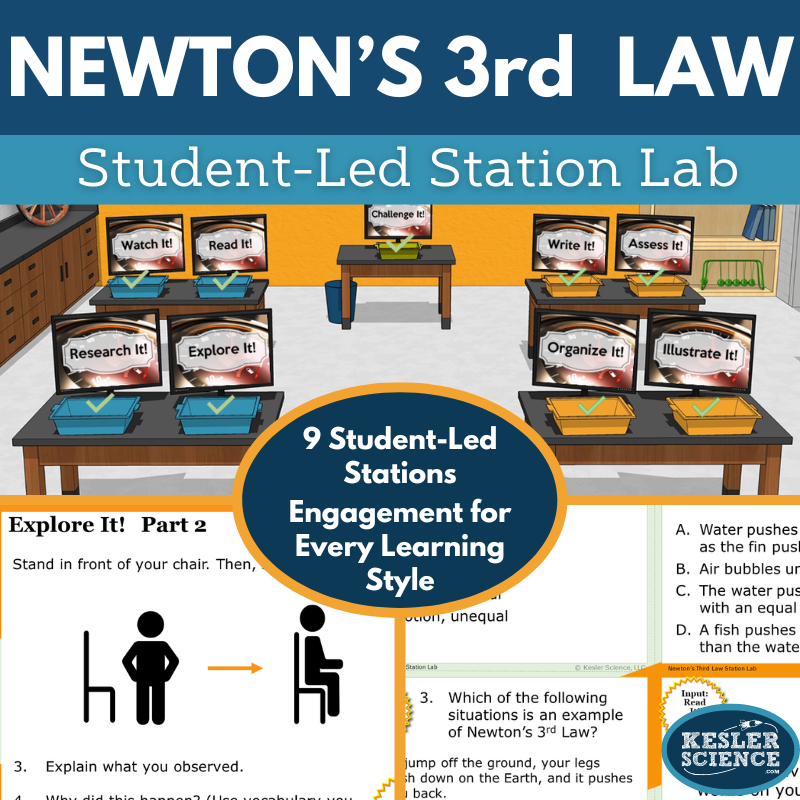

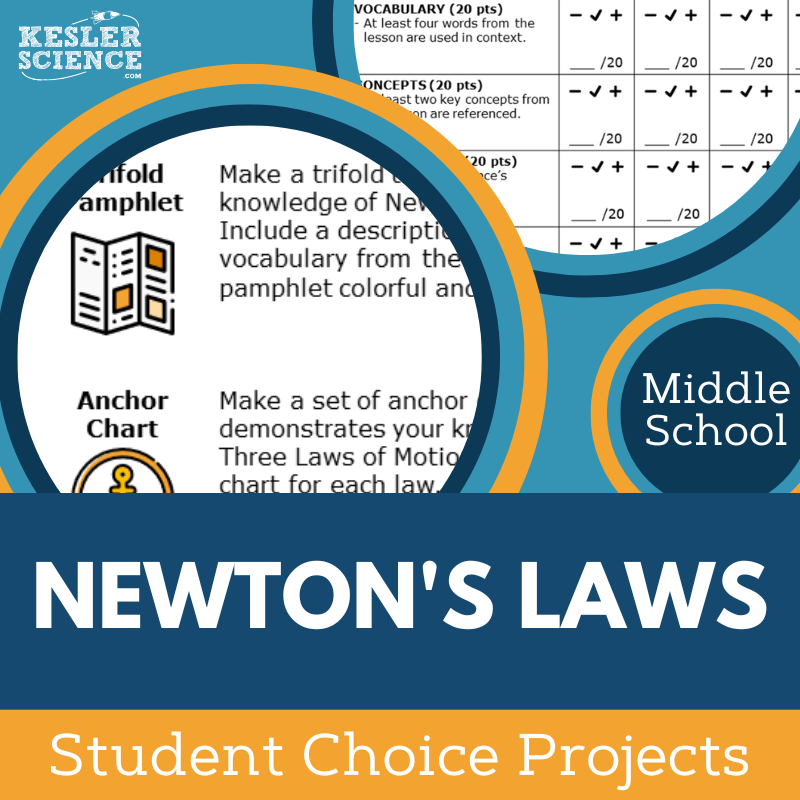

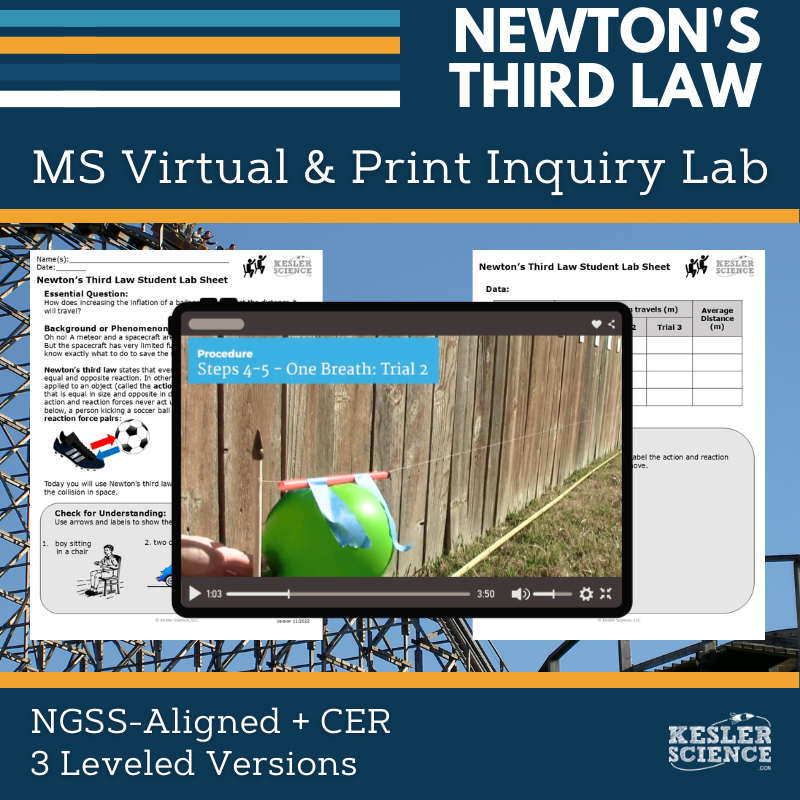

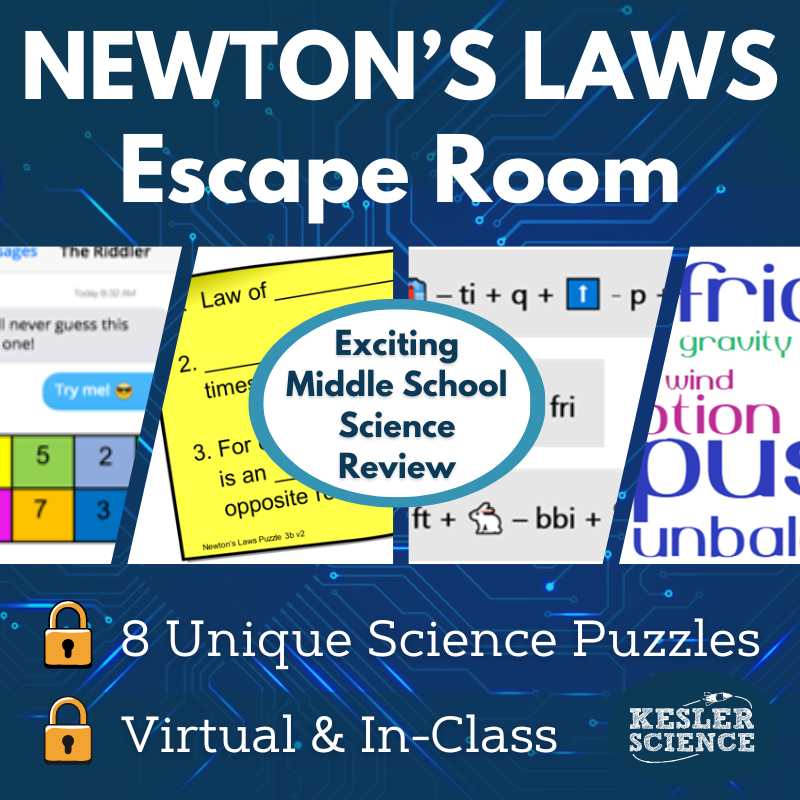

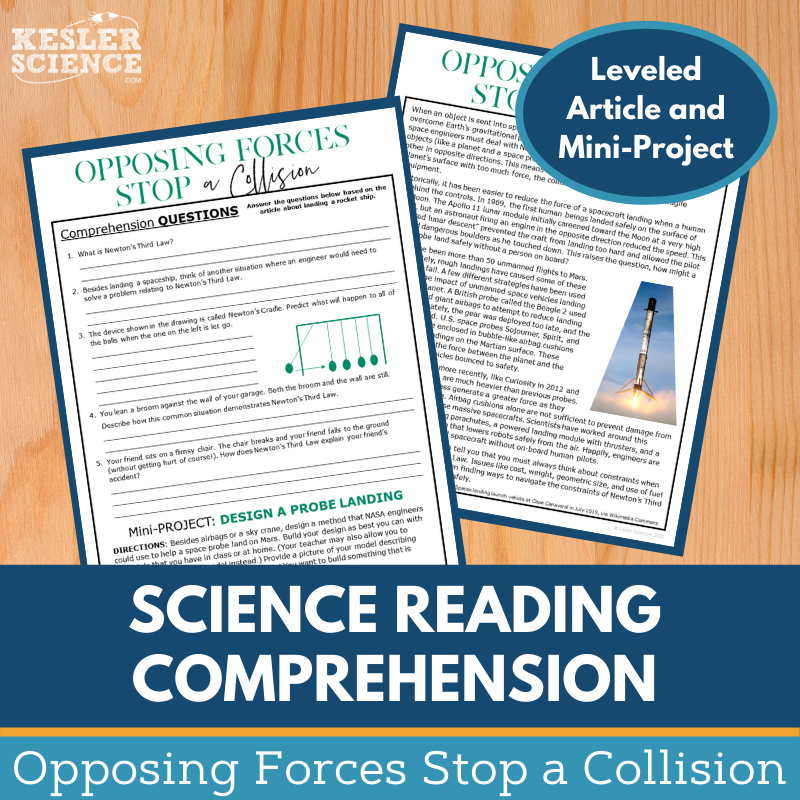

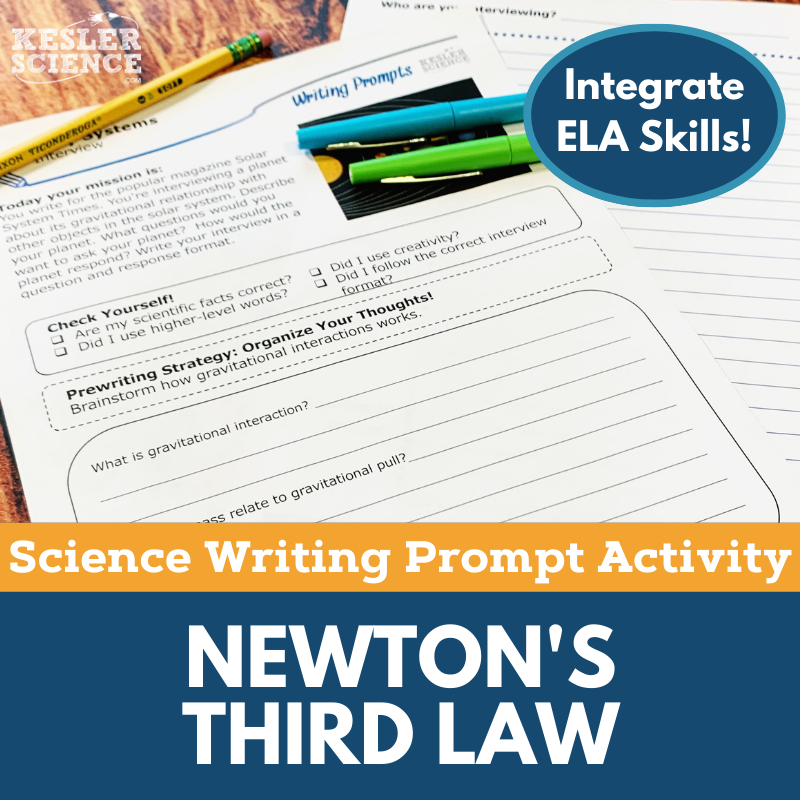

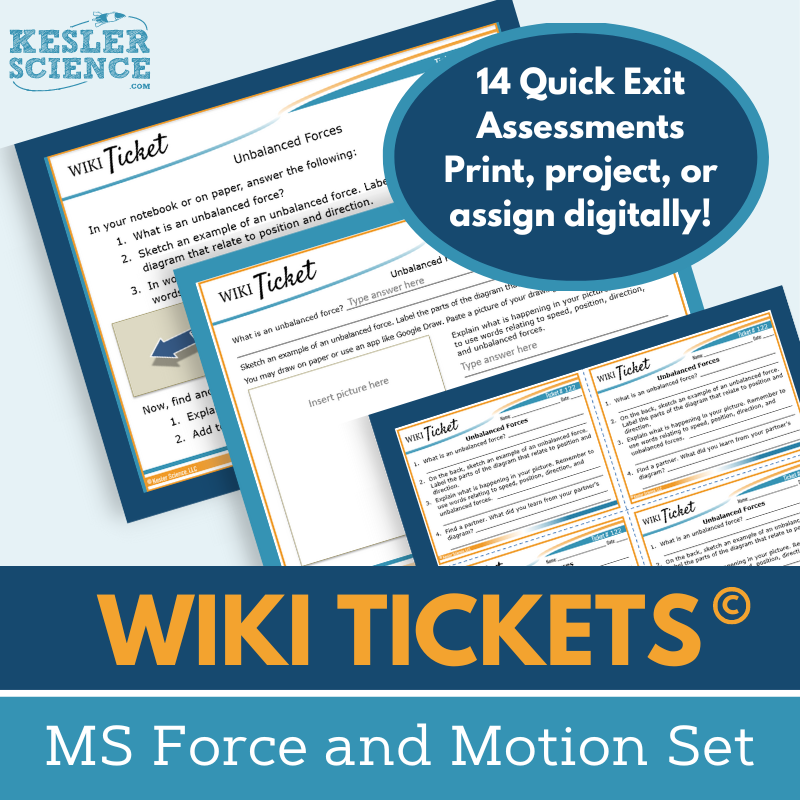

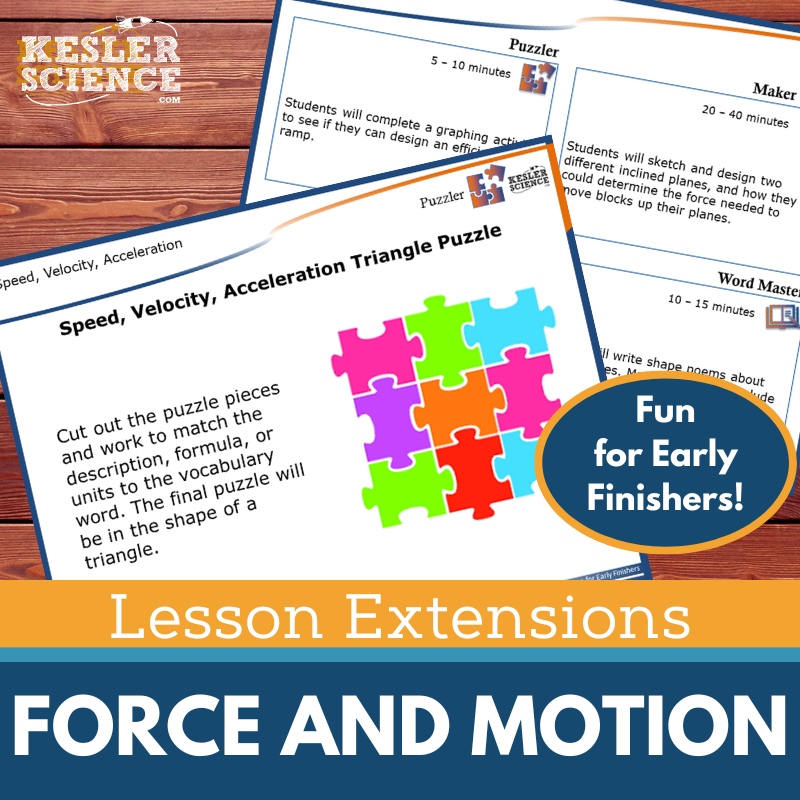

.png)
.png?width=200&height=200&name=Cover-Collisions%20(2).png)
